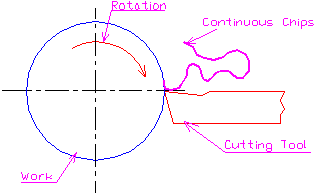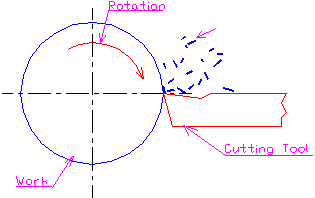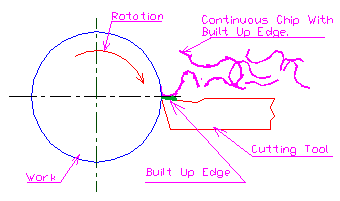Leaving Certificate Engineering
Machining Chip Type
Home
You may have noticed when machining on a lathe or
drilling machine that the swarf comes away as a continuous strip like wire or as small
broken chips. This difference is due to materials properties where continuous chip
(strip) is produced from ductile materials like aluminium and discontinuous chip is
produced from brittle materials such as cast iron. Some materials are alloyed with others
to give discontinuous chip e.g. "Free Cutting" aluminium is alloyed with another
metal so that discontinuous chip is produced. This is especially important with CNC
machining where the operator can not intervene during the cycle.
Continuous
Chip
A continuous chip is formed when machining
ductile material and shearing takes place within the plastic range.

|
The chip comes away as a continuous strip, like wire.
This is because the material is ductile and is still in its plastic state after the cutting/shearing action.
Care must be taken with the disposal of continuous chip as it is
very sharp.
|
Discontinuous chip
A discontinuous chip is formed when machining
brittle material and the shearing takes place outside the plastic range.
 |
The chip breaks up as it is machined
This is because the material is relatively and has gone beyond its elastic limit after the cutting/shearing action.
Brittle materials or free cutting materials produce a discontinuous
chip.
|
Continuous
chip with Built Up Edge.
A continuous chip with built up edge is formed
when machining ductile material and the shearing takes place within the plastic range.
During this time some of the chip becomes pressure welded to the face of the cutting tool
which is known a built up edge.
 |
The chip becomes welded to the top of the cutting tool and
then gets dragged off, giving a very rough surface and chip.
The cutting tool is subjected to high levels of wear and frequent
regrinds are required.
|
| Paddy Keays Engineering Teacher |
Cresent College Comprehensive Limerick Ireland |
| Last updated 10 February 2004. |
email paddykeays@eircom.net |
|
|

